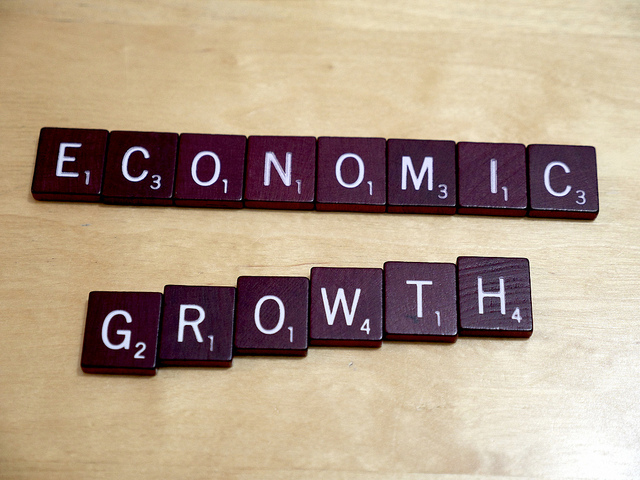Can Economic Growth Continue Forever? Of Course!
Tim Harford, who writes the Financial Times‘s “Undercover Economist” column, has appeared on our blog many times. This guest post is part of a series adapted from his new book The Undercover Economist Strikes Back: How to Run or Ruin an Economy.
Can economic growth continue forever? The internet seems to be full of physicists explaining that economists are clueless on this topic. There’s the late Albert Bartlett’s hugely popular videos – or Tom Murphy’s article “Exponential Economist Meets Finite Physicist.” The key issue is that exponential growth will eventually take you to impossible places. And by eventually, the physicists mean “sooner than we expect.”
Exponential growth is any kind of growth that compounds like interest payments. The classic example is the rice on the chessboard. According to an old story, the inventor of the game of chess was offered a reward by a delighted king. He requested a modest-sounding payment: one grain of rice on the first square of the chessboard, two on the second, four on the third, doubling each time. Yet this is actually a colossal amount—many times the annual rice production of the entire planet.
The chessboard prize was 100 percent growth per square; but 10 percent, 1 percent or even 0.0001 percent—it’s all exponential growth. And it all becomes trouble eventually, because each little bit of growth will itself be multiplied by growth in the future. As Albert Einstein, yet another physicist, is famously said to have declared (but probably did not), “the most powerful force in the universe is compound interest.”
The implication for economic growth seems obvious. Our economy grows at a few percent a year. That hasn’t presented many insuperable problems so far. But growth of a few per cent a year is nevertheless exponential growth, and eventually—the physicists worry—we’ll reach a square on the economic chessboard that we just can’t fill.
Economists understand this point perfectly well. One of the very first people to be called an economist was the Reverend Thomas Malthus, who died almost two hundred years ago. Malthus was worried about exponential population growth, and his math was incontrovertible. Fortunately, in the short term technological progress was faster than population growth. More recently population growth has been slowing down dramatically. There’s every reason to believe that the population of the planet is going to stabilize. I don’t think anybody believes zero population growth is unsustainable.
You might well respond that even if population growth stops, growth in the economy – in GDP – will continue, and fall foul of the rice-on-the-chessboard problem. But I think that here we find a serious gap in the logic of the exponential doomsayers. They’re looking at exponential growth in physical processes—things like heating, cooling, lighting, movement. This is understandable, because they are, after all, physicists. Tom Murphy’s blog post is particularly startling on this point. He points out that if our energy consumption grows at 2.3 percent a year—less than historical rates but enough to increase energy consumption tenfold each century—then the entire planet will reach boiling point in just four centuries. It’s not the greenhouse effect at work; it’s irrelevant to Professor Murphy’s point whether the energy comes from fossil fuels, solar power or fairy dust. This is simply about the waste heat given off, inevitably, when we use energy to do useful work. And it’s pretty hard to argue with the laws of thermodynamics. The calculation sounds shocking, but it’s just the rice on the chessboard all over again.
Here’s the logic lapse: energy growth is not the same as economic growth. GDP merely measures what people are willing to pay for, which is not necessarily connected to the use of energy, or any other physical resource. True, since the beginning of the industrial revolution the two have tended to go hand in hand, but there’s no logical reason why that tendency needs to continue. Indeed, it appears to have stopped already. Would you like to take a guess at energy growth per person in the United States over the last quarter of a century?
It’s not just less than 2.3 percent. It’s less than zero. The same is true for other developed economies such as Germany, Japan and the United Kingdom. Now this is partly due to offshoring to China – but the offshoring effect just doesn’t seem big enough to explain what is going on. It’s also about the changing nature of what is bought and sold in a modern economy.
Think of New York City. It’s a high-income place, and has for more than a century been a creative powerhouse: publishing, music, fashion, art, finance, software, you name it. But energy consumption per person in New York City is lower than in the United States as a whole—in fact, it’s lower than the average in any American state. Ultimately, we can do a lot of the things we value—including value in the grubby pecuniary sense of “are willing to pay lots of cash for”—without expending vast amounts of energy.
It’s easy to grasp why exponential economic growth is not the same as exponential energy growth. If I’m worried about money, I may turn off my heating and wear a coat and hat indoors; a bit of extra money will mean I take off the hat and coat and use more energy. But that doesn’t mean that if I win the lottery I will celebrate by boiling myself alive.
I fully agree with the environmentalists who worry that we cannot continue consuming more and more water, spewing out more and more carbon dioxide and burning more and more coal. The problem comes if we then leap to the conclusion that the economy itself cannot keep growing. Thankfully, that just doesn’t follow.
Reprinted from The Undercover Economist Strikes Back: How to Run or Ruin an Economy by Tim Harford, published by Riverhead Books.


Comments